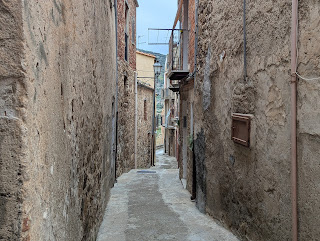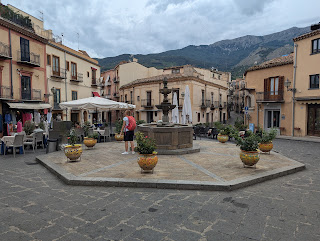Since Steven and I had arrived after dark in a small inn high above Collesanno the night before, we'd had no opportunity to view or appreciate our surroundings. We woke to the sound of cowbells jingling nearby, which made us think we were in Switzerland and not in the wilds of Sicily!
The view from the property to the hills beyond:The noisy cows on the hill opposite us:
I'd felt bad for Steven driving the hilly, gravel roads in the dark, and it wasn't much better in the light of day, either. Once we reached the bottom of the long hill, I joked with Steven I'd left something back at the property. Steven's response: Bummer!
Collesanno's rooftops:
Sure glad I didn't have to climb all those steps for a weekly Mass at the Basilica San Pietro!
The mountaintop town of Collesanno was first settled by Arab conquerors in the 10th century. Its strategic mountain location made it an ideal spot for defending the surrounding fertile lands from new invasions from the Mediterranean.
We realized later we could have driven the car down these extremely narrow lanes but chickened out, preferring to walk to the Castello Medievale Collesanno.
The Medieval Castle was likely built by King William II of Sicily between 1100 and 1200 after he decided to move his administration to a more secure location to draw away invasions from the Middle East and North Africa. It had a square shape, with thick walls, and an inner courtyard. After 1600, it was transformed into a palace owned by various important families. Unfortunately, it was damaged by an earthquake in 1693.
The view over the Madonie Mountains from the castle:
Collesanno was the first town in Sicily where we noticed that many homes had what looked like chain mail or a type of vertical netting. It turned out to be fairly common in other parts of the island, but we didn't know it then. Perhaps it was a type of free airconditioning yet allowed for privacy.
Many doorsteps had bottles of water on them for some reason.
The town's main street was decorated with large ceramic vases every block or so.
En route to the hilltop town of Polizzi Generosa in the heart of Parco delle Madonie:
Polizzi was a critical and thriving city during the Middle Ages that had Generosa added to its name to signify the richness of its agricultural territory. Polizzi, during the Renaissance, was a focus of trade and commerce between the provinces of Messina and Palermo. Because of its importance, there were many examples of art and architecture we wanted to explore. The city was located at the top of a rocky outcrop with 360-degree views of Parco delle Madonie.
I wasn't able to find who the figure was in the mural that graced the main square or the second one on another street.
I just 'had' to get a typical shot of men gathered in the main square as they were a fixture in every Sicilian town we visited.
The Chiesa di Santa Maria Lo Piano, located on the main square, was formerly the seat of the City Senate established by Charles V as the city had the right to a seat in the Sicilian Parliament since it was a royal city.
The former Jesuit Fathers' College and now the Palace of Culture:
The Church of San Girolamo, one of the largest in the city and occupying a whole block on the main street, was one of the few octagonal-shaped churches in Sicily. Designed between the 17th and 18th centuries, it contained precious 17th-century paintings and underground crypts where the bodies of Jesuit priests were temporarily laid to rest. Surprise, surprise, the church was closed as so many had been the day before.
The square on the side of the church:
The Chiesa di Maria Santissima Assunta, the town's mother church, was founded by the Normans before being enlarged in the 14th century and almost completely rebuilt in the 18th century.
A side view of the mother church: We hadn't planned to tour the church but figured we'd better since we'd come a long way, and it was open.
The famous Flemish Triptych by Roger Van der Weyden was painted in the 15th century.
On the next corner was the Chiesa di San Gandolfo La Povera, which was built on the remains of a former hospital.
A couple of blocks away was the now-closed Monastero di Santa Margherita, which dates to 1450. Though it had a very run-down exterior, its interior was described as "a testament to the wealth and luxury that the church acquired from the lands and agricultural wealth of Polizzi Generosa."
Lina: Zacharie would love to follow in the footsteps of the Targa Florio drivers as we did after leaving Polizzi Generosa on the way to the next mountain town!
The roads were in horrific condition, but the lush farmland views were spectacular!
In the distance was our next mountain-topped village, Petralla Sottana, another magical town also located in scenic Parco delle Madonie. Its cathedral appeared like a castle on a hill with the rest of the town cascading down from it! The town's rich history has blessed it with much art and culture that was definitely worth more than the couple of hours we had to explore it.
Piazza della Vittoria or Victory Square:
If we'd had more time, we both would have enjoyed walking around the Civic Museum of Antonio Collisani, which was dedicated to both geology and archaeology. The rocks and fossils in the locally gathered collection date to 200 million years ago!
The location of the Italian Alpine Club:
In the Middle Ages, Petralla Sottanna was under the control of the Ventimiglia family, whose vast wealth left behind many stunning works and buildings in town. The central square of Piazza Umberto I was dominated by the 17th-century Chiesa Madro SS Assunta, dedicated to the Madonna of the Assumption. Its interior was filled with sculptures from the 14th to the 16th centuries, including by Antonio Gagnini, the famed Sicilian sculptor whose works we saw earlier.
Admiring the lovely valley far below:
On a five-minute walk, we'd passed four churches!
Yet another church - this one dated to 1671.
We noticed six of these raised markers(?) on the street and wondered what they were.
Next up on the tortuous road was the mountain town of Castelbuono, 24 km east of Collesanno.
As you can see, we were still following the Targa Florio racing car circuit!
Before you ask, Janina, yes, indeed, the streets were really that empty!
On Piazza Margherita, the town's main square was the Museo del Risorgimento, which was dedicated to several significant historical periods. But, once again, we didn't have the time or much interest to devote to examining local folk traditions. The museum featured a historic bell tower and clock dating to the 1800s.
The view from the museum was far more appealing.
Small chapels in the main square:
On the opposite side of the piazza was the Chiesa Matrice SS Assunta Vecchia, Castelbuono's main cathedral that we'd first seen from the valley floor. It was an elegant 16th-century Romanesque church filled with an ancient baptismal font and a precious polyptych on the main altar.
Finally, after two days, we found a restaurant that was open for a meal - were we happy!
The impressive castle fortress, built by the Ventimiglia family in 1316, was once the town's center and helped Castelbuono become the administrative and defensive capital of the family's enormous kingdom. It later became the family's imposing residence. A familiar refrain, I know - we, unfortunately, didn't have time to admire the family chapel inside the castle that had been decorated by Siciliam master sculptors Giuseppe and Giacomo Serpotta (remember the lizard in the Oratorio!) and Antonello Gagnini. If you ever have a chance to visit, make sure to take pictures for me of the castle museum's ancient Greek ceramics and items from the Bronze Age as we missed out on those, too!
We knew that Castelbuono enjoyed the rare privilege of being one of the few places in the world that grows a certain type of ash tree. These trees were the producers of Manna, which fed the Israelites when they were in exile in the desert. Much as we would have loved to have seen the special trees, we had no clue what they looked like and therefore, left Castelbuono without a glimpse of them.
I wish we'd known in advance how attractive Castelbuono was as, in hindsight, we should have stayed there for the night. It was by far the biggest town we'd visited so far that day and it would have been so relaxing to call it quits there for the day! But we pressed on to ...
Next post: Onwards to Cefalu, the jewel of the Tyrrhenian Coast!
Posted on November 19th, 2024, from my hometown of Ottawa, Canada, where I flew to from Chicago to spend several days with my four brothers, one of whom is very sick. Please make sure to take care of yourself and your loved ones as life can throw you far too many curveballs.













































































Neat photo of the map on your cell phone. Not sure I would want to drive it. JDK
ReplyDeleteI was glad to be just the navigator, Janina, believe me. That way, I could safely close my eyes in hairy spots!
ReplyDeleteI will be sure to share your post with Zacharie; I have no doubt he will be highly intrigued by the Targa Florio racing circuit's tight twists and turns.. wonder if he's up for the challenge ? Lina xo
ReplyDeleteI'm convinced Zacharie would up for the Targa Florio challenge, Lina, since he's already competed in many esteemed road races!
DeleteLove and hugs right back at you.